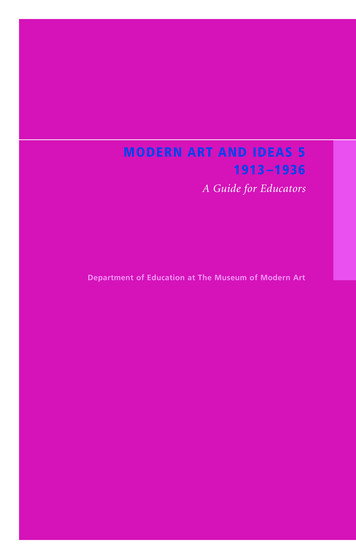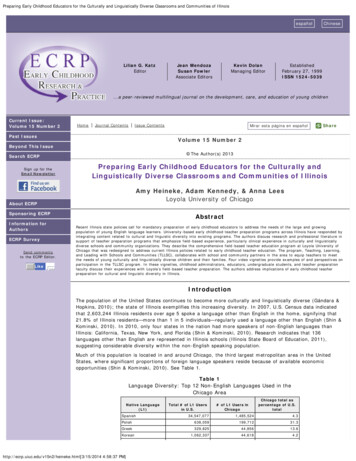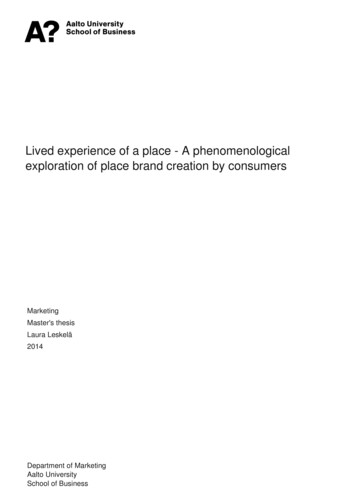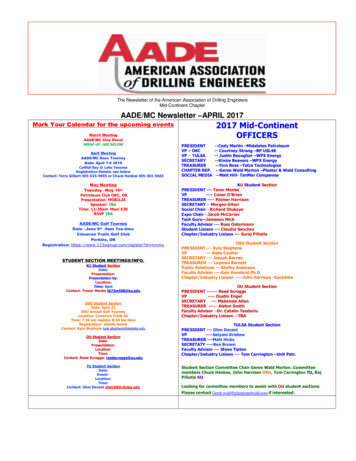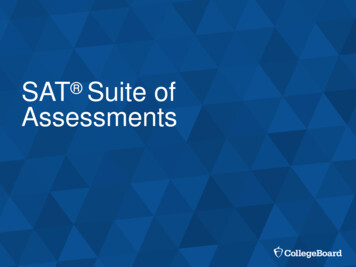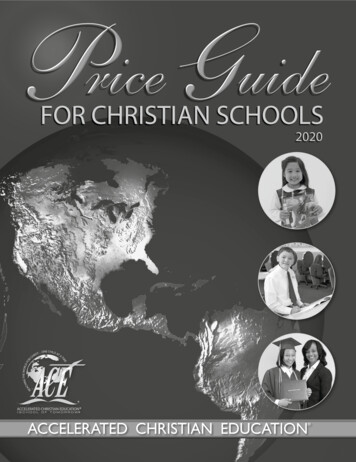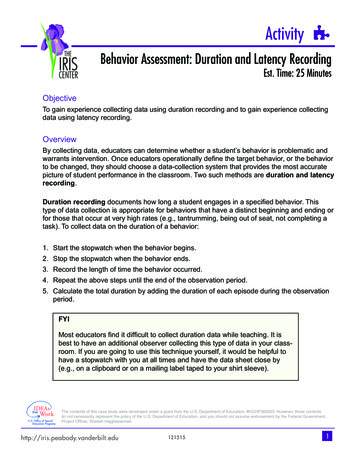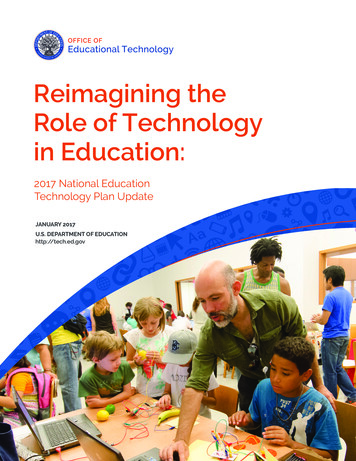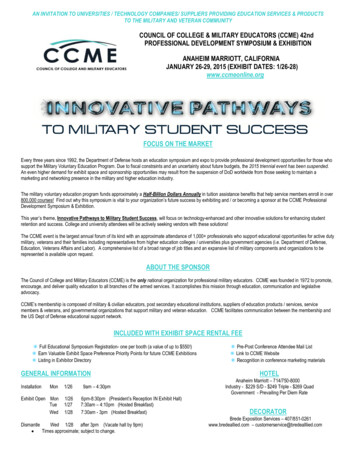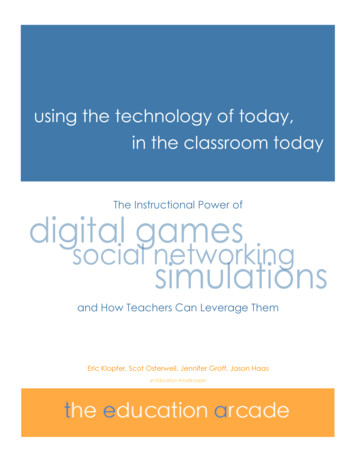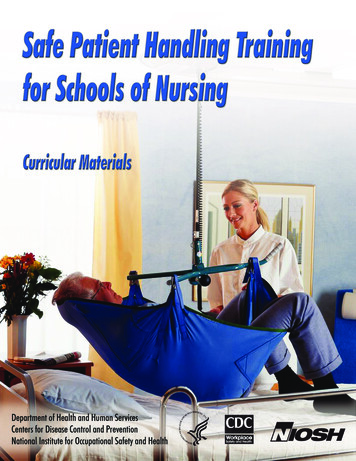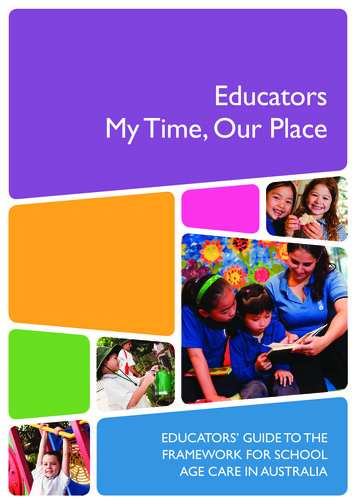
Transcription
EducatorsMy Time, Our PlaceEDUCATORS’ GUIDE TO THEFRAMEWORK FOR SCHOOLAGE CARE IN AUSTRALIA
Produced by the Australian Government Department of Education, Employment and WorkplaceRelations.ISBN 978-0-642-78282-3 [PRINT]ISBN 978-0-642-78283-0 [PDF]ISBN 978-0-642-78284-7 [RTF]With the exception of the Commonwealth Coat of Arms, the Department’s logo, any material protected by a trade mark andwhere otherwise noted all material presented in this document is provided under a Creative Commons Attribution 3.0 d/3.0/au/) licence.The details of the relevant licence conditions are available on the Creative Commons website (accessible using the links provided)as is the full legal code for the CC BY-ND 3.0 AU licence legalcode).The document must be attributed as the Educators’ Guide to the Framework For School Age Care In Australia.
CONTENTS1INTRODUCTION: USING THE GUIDE WITH THE FRAMEWORK32ONGOING LEARNING AND REFLECTIVE PRACTICE FOR IMPROVEMENT63DECISION MAKING: IMPLEMENTING THE FRAMEWORK114LINKING BELIEFS AND THEORY WITH PRACTICE215HOLISTIC APPROACHES266COLLABORATING WITH CHILDREN317LEARNING THROUGH PLAY358INTENTIONALITY429ENVIRONMENTS4810 CULTURAL COMPETENCE5711 THE JOURNEY FOR EDUCATORS:GROWING COMPETENCE IN WORKING WITH AUSTRALIAN ABORIGINALAND TORRES STRAIT ISLANDER CULTURES6112 CONTINUITY AND TRANSITIONS6713 EVALUATION FOR WELLBEINGAND LEARNING7214 OUTCOMES8115 GLOSSARY OF TERMS8516 REFERENCES AND RESOURCES87
ABBREVIATIONS USED IN THIS DOCUMENTThe Framework: My Time, Our Place—Framework for School Age Care in AustraliaThe Guide: Educators My Time, Our Place—Educators’ Guide to the Framework for School Age Care in AustraliaThe terms used in the Guide are consistent with the Framework. For explanation, see the definition boxes andglossary in the Framework.
1INTRODUCTION: USING THEGUIDE WITH THE FRAMEWORKWHAT THE FRAMEWORK SAYSThe Framework is designed to inspireconversations, improve communication andprovide a common language about children’s play,leisure and learning among children themselves,their families, the broader community, school agecare educators and other professionals.(The Framework, p.6)The Educators’ Guide has been developed tosupport the professional practice of those who areresponsible for the interactions, experiences, routinesand events, planned and unplanned, that occur ina school age care environment designed to fosterchildren’s wellbeing, development and learning. Itfocuses on aspects of pedagogy including buildingand nurturing relationships, program decision-making,teaching and learning.A NEW VISION FOR SCHOOL AGECARE IN AUSTRALIA—LEARNINGTHROUGH PLAY AND LEISUREIn school age care settings, educators encouragechildren’s engagement in a range of play and leisureexperiences that allow them to feel happy, safe andrelaxed, and to interact with friends, practice socialskills, solve problems, try new experiences, and learnlife skills. Educators providing education and careto school age children need to have the skills andunderstandings about the many facets of children’slives and what it means to support their learning andcare for them in a school age care setting.While there has been considerable investigationand research undertaken about the various aspectsof schools, there has been limited research whichfocuses on school age care. Educators should acquirerigorous knowledge about educating and caring forschool age children, equipping them to understandthe holistic life of a child, rather than just the ‘school’or ‘care’ experiences. School age care is an alternativeto home environments as ‘places of childhood’, wherechildren spend time developing the knowledge andskills for citizenship. It occurs in a range of settingssuch as before or after school care, school holidaycare or vacation care.The vision for educators is encouraged andsupported by the Framework which is written toextend and enrich children’s experiences in schoolage care settings. It is based on the principles laidout in the United Nations Convention on the Rightsof the Child which states that all children have theright to relax and play, and to join in a wide range ofcultural, artistic and other recreational experiences.The Convention also recognises children’s rights tobe active participants in all matters affecting theirlives and respects their familial, cultural and otheridentities and languages. It is critical that educatorshave an understanding of all these matters, togetherwith an understanding of themselves gained throughreflective processes. They need to be encouragedto engage in critical reflection about their moralresponsibility to children in the care setting to betterprepare them for the responsibility that they have toall children and the wider community.Most significant to Australia’s Indigenous peoplesis their ancestral relatedness to country. TheFramework supports the commitment of The Councilof Australian Governments to closing the gap ineducational achievements between Indigenous andnon-Indigenous Australians within a decade.The Guide is intended to support educators toexplore the roles and responsibilities associatedwith their work in the school age care sector. Itbuilds on the content and themes identified in theFramework. The emphasis in the Framework is onthe importance of play in the life of a school agechild’s life. It encourages educators to consider theplanned or intentional opportunities for play as wellas spontaneous play.EDUCATORS My Time, Our Place3
A NEW VISION FOR EDUCATORS‘The term educator is used to refer to practitionerswhose primary function in Australian school agecare settings is to plan and implement programsthat support children’s wellbeing, developmentand learning.’(The Framework, p. 4)When educators reflect on their role in children’slives they reflect on their own views andunderstandings of theory, research and practice.This Guide provides educators with underpinningknowledge about the theories, research andpractices that are most relevant to children in themiddle childhood phase. All children demonstratetheir learning in different ways. Educators, therefore,need to be able to reflect on children’s wellbeingand how they have developed, as well as how theyhave engaged with increasingly complex ideas andparticipated in increasingly sophisticated experiencesfrom a variety of perspectives. They need toacknowledge approaches that are culturally andlinguistically relevant; be responsiveto children’s social, physical and intellectualcapabilities; acknowledge children’s abilitiesand strengths; and allow them to demonstratecompetence. Educators collaborate with childrenand use strategies that support and empower themto see themselves as capable and foster in themindependence and initiative.‘When an adult cares for and interacts withchildren in ways that demonstrate positive regardand genuine interest in the health and wellbeing ofanother human being, then they are an educator.Child Care Workers are educators when theyprovide wholesome food—they are teachingchildren the value of healthy lifestyle Child CareWorkers are educators when they are responsiveand warm to children’s needs and interests—theyare teaching children to feel safe, supported andincluded Child Care Workers are educators whenthey plan play and leisure experiences—they areteaching children skills of cooperation, engagementand inventiveness How can we say that ChildCare Workers are not educators?’(School Principal)4EDUCATORS My Time, Our PlaceWhen educators collaborate with families, othereducators and professionals to meet children’sneeds, they can enhance children’s wellbeing anddevelopment.USING THE GUIDEThe Guide is designed to be used by individuals andteams in interactive ways to promote conversationsand thinking about the concepts which underpinthe Framework. It is not intended to be read in onesitting. Rather, individuals and teams of educatorsmay find it helpful to ‘dip’ into the Guide at differentpoints, to focus on one section at a time, and tobegin with the section of most interest to them. Mostreaders will find it helpful to read the Frameworkbefore turning to the Guide. The following conceptsof the Framework are explored in the Guide: principles, practices and pedagogy, includinglearning through play, intentionality andcollaboration with children to support learningand wellbeing reflective practice implementing the Framework to foster children’swellbeing and learning through play in areasidentified by five broad outcomes for children facilitating children’s transitions between home,school age care setting and school developing cultural competence Australian Aboriginal and Torres Strait Islandercultural competence exploring your own personal beliefs and usingtheoretical perspectives.Both the Framework and the Guide are designed toengage educators in critical thinking and reflection.As such, they are not prescriptive or ‘recipe’ books,but rather are intended to provoke, inspire andchallenge. They recognise that there is not one ‘rightway’ to provide for children’s wellbeing and learning.If we think there is just one right way and if we haveno doubt about the quality of our provision, we leavelittle room for reflection, for questioning orfor change.The sections that follow this Introduction all havea similar format. Each major section starts with aquote from the Framework and then is divided intothe following segments which help you to exploreparticular concepts in the Guide:Think and reflect about—explanatory informationabout the section, including reflective questions andsuggestions for going deeper
Hear about—stories and models of practiceTry out—possible entry pointsFind out more about—links to otherresources and tools.The case studies used in the guide are examplesof practice and are designed to promote criticalreflection rather than identifying any particularapproach.Learning stories, educator reflections, children’s voiceand photos are included as examples of practice thatillustrate the links between the principles, practiceand outcomes for children. Each section will alsoidentify additional resources that can assist educatorsto critically reflect on pedagogy, relationships and theconnection with children’s wellbeing and involvementin learning.Additional materials and some tools are available onthe accompanying resource CD.EDUCATORS My Time, Our Place5
2ONGOING LEARNINGAND REFLECTIVE PRACTICEFOR IMPROVEMENTWHAT THE FRAMEWORK SAYSCritical reflection involves closely examining allaspects of events and experiences from differentperspectives. Educators often frame their reflectivepractice within a set of overarching questions,developing more specific questions for particularareas of enquiry.(The Framework, p.11)Ongoing learning and reflective practice is one ofthe key principles of the Framework. Reflectivepractice is a form of ongoing learning that involvesengaging with questions of philosophy, ethics andpractice. Educators continually seek ways to buildtheir professional knowledge and develop learningcommunities. They collaborate with children, familiesand community, and value the continuity and richnessof local knowledge shared by community members,including Aboriginal and Torres Strait IslanderElders, through culturally competent practices. Theintention is to gather information and gain insightsthat support, inform and enrich decision-makingabout children’s wellbeing and development. Asprofessionals, educators examine what happens intheir settings and reflect on what they might change.The Guide and the Framework aim to makereflective practice and inquiry a part of everydaypractice. This Guide supports educators to bereflective by providing: critical questions to think about and reflect upon ideas to promote a culture of inquiry a process for inquiry.THINK AND REFLECT ABOUTIn school age care settings, educators engagein reflective practice that describe, analyse andsynthesise their thoughts and ideas about theprogram, the principles and practices, and theoutcomes for children. Opportunities for reflective6EDUCATORS My Time, Our Placepractice could include discussions or conversationsor perhaps writing in journals. The reflectiveprocesses provide educators with the skills toenhance their professional learning, improvingpractice and knowledge, and help them to thinkabout ways they can support children’s developmentand wellbeing.When educators participate in reflective processes,they need to have knowledge about children and howthey develop and learn. For educators to undertaketheir role, they need to draw upon a multiplicity ofareas, including knowledge of school age children’sdevelopment and wellbeing, organisation, andcommunity development.School age care educators have a professionalresponsibility and it is within the context of thisresponsibility that educators need to make complexdecisions, reflect on action, and collaborate withcolleagues. They need to be empowered to makedecisions about issues within their programs.They need the confidence to act and the ability toparticipate actively and creatively, rather than bepassive recipients of others’ actions. Educators mustdevelop their own beliefs and values in relation totheir pedagogy in the light of their understanding oftheory and research to provide quality programs.Reflective practice is considered to be an essentialtechnique for promoting such critical inquiry.The literature about reflective practice is diverse.Reflective practice and thinking are not newpractices. They can be linked to the work of Dewey,who suggested that reflective thinking meansturning a subject over in the mind to give it seriousconsideration, enabling one to act in a deliberateand intentional manner. Using reflective practicegives educators confidence in their ability to carryout their complex role. Reflective practice takes forgranted the ability of educators to stand back fromtheir practice and look at their actions objectively.This may be difficult for some individuals because oftime constraints, or the situation in which they work,or their temperament.
There are different types and levels of reflection. Forexample, descriptive reflection is considered to bemore easily mastered. It describes the events thathave occurred with no attempts to provide reasonsor justifications for the events, whereas criticalreflection requires knowledge and experiencesthat take time to develop. In school age caresettings, more experienced educators will needto help emerging educators to develop the skills,understandings and knowledge base that will enablethem to engage in reflective practice and ongoinglearning effectively.For reflective processes to occur, educators needtime, compatible colleagues, a conducive climate,and explicit administrative support (Wildman et al,1990). Sharing one’s perceptions and beliefs withothers through reflection may lead to self blame forany perceived weakness (Wildman & Niles, cited inHatton & Smith 1995). On the other hand, the role ofdialogue with a ‘compatible other’ is seen to facilitatereflection by helping the individual to shape andclarify their ideas. A high degree of verbal interactionwith a trusted other, such as colleague, other staffor the children, can enhance confidence in the selfas a learner. The kinds of questions asked can elicitreflective responses and can contribute to the valuingof personal experience and the confidence in one’scapacity to generate knowledge. Educators need toconsciously use well-developed active listening skills;identify personal goals; recognise presuppositionsStepsin language use; and mediate and clarify questionswhen they are engaged in the reflective process.Conversational communities are a useful strategyfor supporting reflective practice in school agecare settings (Griffiths & Tann, 1992, p.79). Thesecommunities are a place for engaging in discourse,debate, risk taking, analysis and re-theorising aboutschool age care practices.It must be noted that journal entries made byeducators may underestimate the degree of reflectionundertaken: more significant reflection may havetaken place during the events or in the discussionsat the time of the events that is not evident in thewriting. The educator’s ability to reflect on theirwork provides them with the feedback to nurturetheir self esteem and professional growth. Reflection,particularly critical reflection, can contribute to this,but it can be challenging (Hatton & Smith, 1995).Conversations need to be scaffolded in a way whichsupports self-reflection. Developing a set of criticalquestions is a strategy that promotes and models theskills essential for critical reflection.Groups of educators conversing together can engagein some deeply reflective practice. One such modelis termed Circles of Change (COC) (Macfarlane &Cartmel, 2007) in which educators use a reflectivemodel with questions to scaffold the reflectiveprocess as described below.Action in conversationQuestions to be asked1. DeconstructDescribe andunpackPull apart practices and closely examinetheir makeup, especially practices that havebeen enshrined as ‘normal’ and ‘proper’practice.What happened?2. ConfrontApproachpersonal, socialand systemicissues head onby examiningdifficult,previouslythought ofas ‘sensitive’topicsThis stage is useful for prospectivepractitioners as they focus on theirown practice and confront issues thatarise during the course of their day.The democracy and safety that COCprovides enables opportunities for moreexperienced practitioners to point outhow important it is to confront issuespertinent to their own practice.What is working well?What are your challenges?EDUCATORS My Time, Our Place7
3. TheoriseCarefullyconsiderpractice atall levels andquestionwhat isThis stage is useful for educators tounderstand the importance of linkingtheory to practice and the need toapply what is learned theoretically towhat is implemented in the programs.Educators can explore how theories andresearch influence practice and identifywhat knowledge is privileged over otherknowledge.What literature/ research/ experiencehelps you to understand what ishappening?Refer to the resource CD for a summaryof relevant theories.4. ThinkotherwiseChallengeyourself tothink outsidethe dominantideas andcome up withother ways, orbetter ways ofpractisingThis stage is useful for educators as theyrecognise there are multiple perspectivesand a variety of opinions aboutprofessional practices.In this case, the COC approach provides educatorswith useful reflective tools and, as such, improvestheir capacity to engage in teamwork, collaborativedecision-making, and reflective practices, and tofinely tune generic skills required for effective lifelongWhat do you need to change about yourpractice?What are the first steps?learning and practice in the school age care sector. Itis important that participants are accepted for theircontribution and that recognition is given to the tacitknowledge (Osmond & O’Connor, 2004) that eachperson already possesses.HEAR ABOUTOne team’s take on reflective practiceThe introduction of the National Quality Framework and My Time Our Place; new words like ‘pedagogy’;and the idea that we were now ‘educators’ sent everyone reeling. So much new information with no listof instructions of ‘do it this way’. And then this idea of reflective practice! The idea of talking openly aboutour professional practices was confronting and challenging. What is reflective practice and how can we findout? How could it be useful?Together as a team of educators we decided to devote a staff meeting to researching information aboutreflective practice, what it was, and how we could begin to use it. Our task was to then discuss andshare our research with the rest of the team.We began to realise that our review of daily practices andprocedures, which had always been a normal part of our staff meetings, was actually reflective practice.We regularly assess how effective our practices and procedures are by reflecting on current experiences,feedback from children and families, and new knowledge or information about children. Do they achievewhat they are designed for? Who do they serve? For example, are they designed for the convenience ofstaff or to meet outcomes for children? Do they reflect our service philosophy or policies? Could we do itbetter or differently? Is there new information that we should think about or consider?We realised we had done this before. How else could we start to use reflective practice? As a result ofa brainstorming session, we had created quite a list of ideas from which we could start to develop ourskills in talking about what we do and why. We hoped that the practice would develop our confidence asprofessionals —for some of us it has been a difficult process to think of ourselves as either professionalsor educators, but our confidence is growing: it is a part of our journey of belonging, being and becoming.8EDUCATORS My Time, Our Place
As a team we identified three steps in reflective practice:STOP—educators needed time to think and record reflections. This is now scheduled into ourdaily practiceTHINK—what happened? What were the outcomes? Who was involved? Celebrate what is working well.CHANGE—does our current practice need to change to improve outcomes for children? Who do weneed to collaborate with? Do we need to access training or professional learning?Reflective practice is becoming a natural part of our daily practice, we are becoming more comfortable inlooking at how we are working and how we can improve, but we are also more aware of the great workthat we are already doing and make more of an effort to acknowledge this.[Reflection] is a practice that enables childcare professionals to consider why certain practices orexperiences do or do not work, and how to use this information to support change and continuingimprovement.(NCAC, 2011, p.1)TRY OUTReflective practice will help educators learn how to use the Framework as well as learn about their ownpractices and the principles that underpin them. Use the following questions to help educators beginreflective practice:BeforeWhat are your thoughts before commencing a reflective practice session?What are your feelings before commencing a reflective practice session?Describe some of the plans or intentions you have for undertaking a reflective session?AfterWhat are your thoughts now?What did you make of that?What do you understand about the type of questions asked during the session?What was influencing your understanding?Were you having any internal thoughts, feeling or reactions about reflective practice that you did not sharewith your colleagues? What were they?What would you have liked to have seen happen?Once educators become familiar with using these questions in reflective practice sessions with othereducators (and children), and convinced of the benefits in their practice, they find it easier to includeongoing reflection and self-evaluation as part of their daily practice. It will reap rewards, particularly inachieving high quality programs in school age care, as it supports the kinds of questions that need to beasked in developing a Quality Improvement Plan as part of the National Quality Framework.EDUCATORS My Time, Our Place9
FIND OUT MORE ABOUTCartmel J (2011) ‘A considered curriculum for preparing human services practitioners: Structuring circlesof learning and change’, in Billet, S. (ed) Promoting Professional Learning, Springer, New YorkCasley M & Cartmel J (2009) Dialogues of Discovery, Early Childhood Australia, Queensland BranchDepartment of Education and Children’s Services (2007) REFLECT RESPECT RELATE: Assessing for Learningand Development in the Early Years, DECS Publishing, AdelaideDepartment of Education and Early Childhood Development (2010) Evidence Paper ‘Practice Principle 8:Reflective Practice’,Victoria: Melbourne Graduate School of EducationEarly Childhood Australia, Early Years Learning Framework Professional Learning Program rg.au/eylfplp/#link4Macfarlane K & Cartmel J (2007) ‘Circles of Change revisited’, report written for the Professional SkillsCoordinator, Queensland Health and Community Services Workforce Council, BrisbaneOsmond J & Darlington Y (2005) ‘Reflective analysis: Techniques for facilitating reflection’, Australian SocialWork, 58 (1), 3-14.Professional Support Coordinator Alliance (2009) Child care Staff: Learning and Growing through ProfessionalDevelopment, PSCA, available athttp://www.pscsa.org.au/cms/?q system/files/FINAL resource manual.pdfStanfield B (2000) The Art of Focused Conversation: 100 ways to access group wisdom in the workplace,Institute of Cultural Affairs & New Society Publishers, CanadaOn the resource CD Reflective practice for improvement Conversations matter: Leading teams in reflective conversation Pedagogical leadership Summary of reflective questions from the GuideEducator reflections Reflecting on links with ‘our’ community Focus on healthy eating Reflecting on cultural competence10EDUCATORS My Time, Our Place
3DECISION MAKING: IMPLEMENTINGTHE FRAMEWORKWHAT THE FRAMEWORK SAYSWorking in collaboration with children and inpartnership with families, educators use theOutcomes to guide their planning for children’swellbeing and learning.(The Framework, p.6)THINK AND REFLECT ABOUTThe Framework is not a curriculum. The Frameworkprovides a guide about the roles and responsibilitiesof school age care educators. It encourages educatorsto draw on philosophies, values, pedagogical theoriesand beliefs to create a vibrant school age care culturefocused on relationships and inquiry. The broaddirection it provides is based on bodies of researcharound education, brain development, health andwellbeing, and the importance of play. The Frameworkfocuses on best outcomes for children aroundtheir development and wellbeing. Implementing theFramework is about implementing an ongoing cycleof reflective practice drawing on information fromthe context of each particular setting. Therefore, theFramework cannot be implemented simply by readingand following a book.Children are learning all the time and, as educators,we should work hard to ensure they are learningthings that will enable them to be happy, healthy andfulfilled. As Norton Juster stated in The PhantomTollbooth: ‘But it’s not just learning things that isimportant. It’s learning what to do with what you learnand learning why you learn things at all that matters’.Learning in school age care settings assists childrento use what they have learnt at school in a real lifecontext.Developing relationships and partnerships with allfamilies, including Aboriginal and Torres Strait Islanderfamilies is integral to ongoing, open and honestcommunication. Culturally competent educatorsacknowledge the diversity of communities and areinclusive of all family groups.Programs that are culturally appropriate anddeveloped in consultation with families andcommunity will ensure that children and families,including Aboriginal and Torres Strait Islander childrenand families, are actively participating and contributingtheir knowledge and ideas as learning evolves. TheFramework enables us to incorporate contemporarytheory and research; educator skills and knowledge;collaboration with children; and partnerships withfamilies and culture to develop best practice forprogram planning, as demonstrated in Figure 1.As educators, we must take all these aspects intoconsideration when undertaking program planning.Figure 1: The components of program planningContemporarytheoryand researchEducator skillsand knowledgeCollaborationwith childrenFamily andcultureBest practiceprogramplanningEDUCATORS My Time, Our Place11
As the Framework suggests, the programencompasses far more than just a list of plannedexperiences. So when program planning, educatorsneed to consider such things as the environment, theroutines, the everyday resources, and even the skillsand knowledge of the educators who work with thechildren.As children explore relationships, resources andexperiences in a thoughtfully planned environment,educators move through a continual cycle ofobservation and reflection, questioning, planning andacting, as demonstrated in Figure 2.Figure 2: Program planningOBSERVE /REVIEWQUESTIONACT / DOPLANA school age care program encompass all theinteractions, experiences, routines and events,planned and unplanned, which occur in anenvironment designed to support wellbeing andfoster children’s learning and development.(The Framework, p.6)Planning is therefore an ongoing cycle underpinnedby reflective practice. Effective forward planning willenable the success of any service. It operates as acontinuous ‘cycle of inquiry’ which includes stoppingto think about how and why we’re doing thingsthe way we are, examining our answers to thesequestions from different perspectives, and using thedeeper understandings we develop as a referencepoint for deciding what actions or changes we wantto make. This current method of ongoing and cyclicplanning is demonstrated in Figure 3 and elaboratedon further in this chapter. It may effectively be linkedto developing a Quality Improvement Plan as part ofthe National Quality Framework.Figure 3: Ongoing and cyclic program planningOBSERVE /REVIEW76ImplementplansPlanexperiencesACT / DO12EDUCATORS My Time, Our Place8 1Assess andevaluateplanned andunplannedlearningExploreknowledge,beliefs andtheories toconstructphilosophyTHE PROCESSOF PROGRAMPLANNING ISONGOINGAND CYCLIC5 4DeviseevaluationmethodsDefineeducator roleQUESTION23Identifyindividualand groupstrengths andinterestsDevise learningenvironmentPLAN
DE-CONSTRUCTING THE CYCLEQuestion1Knowledge and beliefs: At the core ofprogram planning is investigating our knowledgeand beliefs and the practices that are linked to these.Educators constantly
holistic approaches 26. 6 . collaborating with children 31. 7 . learning through play 35. 8 . intentionality 42. 9 . environments 48. 10 . cultural competence 57. 11 . the journey for educators: growing competence in working with australian aboriginal . and torres strait islander cultures. 61
